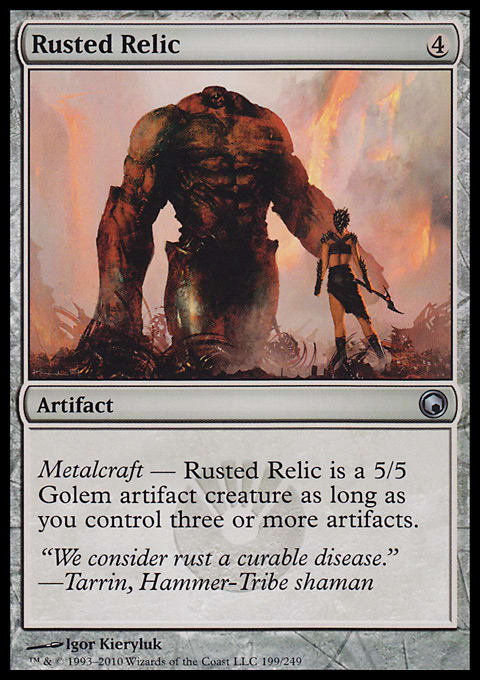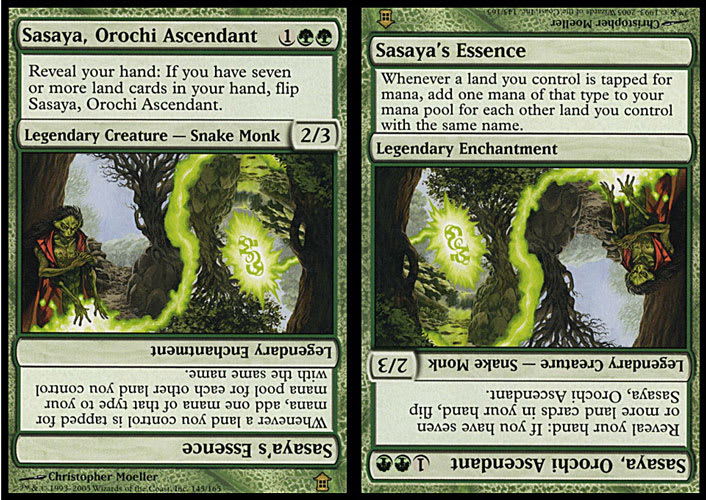Compared to many of the other Magic bloggers out there, I could probably still be considered a Magic rookie. I’ve only played Magic since the Zendikar block (February of 2010, specifically). So, I think of Chaos Magic like I would of a recently-purchased used car: “New to me.”
When I first constructed my ’93–’95 Cube (which only uses cards printed during those three years), I was a little dismayed because so many of the games were slow, even boring. Short of having a few grand to drop on the Power Nine, I had to figure out a way to speed things along. I stumbled upon the Chaos Deck and decided to give it a try.
The Rules, in Brief
From the official MTG site:
This means sorceries and instants resolve immediately, with all players simultaneously acting as the active player. If Explosive Vegetation flips up, all players go digging for lands. If Sundering Growth flips up, all players target an artifact or enchantment, then populate. (It’s up to you and your playgroup to figure out the order of when players choose their targets. I suggest random dice roles.) Any kicker costs or other casting requirements are always considered paid. Flashback, dredge, buyback, and other abilities that let players reuse cards are ignored.
Artifacts and enchantments immediately affect every player in the game (similar to the effect that global enchantments or the old enchant world cards have). Creature abilities act the same way. For example, when Whirlpool Rider flips up, all players shuffle the cards from their hands into their libraries and draw that many cards.
If you do some Google searching of your own, you’ll find that there are a lot of variations on the rules for Chaos Magic. My playgroup followed the rules listed here. However, the link from 2004 included above—and many other sites—have slightly different rulings.
My First Chaos Deck
"Chaos Deck"
- Creatures (6)
- 1 Arbiter of Knollridge
- 1 Dragonlair spider
- 1 Mnemonic Wall
- 1 Wandering Eye
- 1 Whirlpool Rider
- 1 Horobi, Death's Wail
- Spells (32)
- 1 Congregation at Dawn
- 1 Sundering Growth
- 1 Beast Hunt
- 1 Breath of Life
- 1 Chill of Foreboding
- 1 Conqueror's Pledge
- 1 Explosive Vegetation
- 1 Hellion Eruption
- 1 Hunters' Feast
- 1 Innocent Blood
- 1 Lead the Stampede
- 1 Living Death
- 1 Make a Wish
- 1 Mass Polymorph
- 1 Minds Aglow
- 1 Molten Psyche
- 1 Planar Cleansing
- 1 Pyroclasm
- 1 Restore Balance
- 1 Spider Spawning
- 1 Stronghold Discipline
- 1 Sway of the Stars
- 1 Time Reversal
- 1 Violent Ultimatum
- 1 Feudkiller's Verdict
- 1 Death's Presence
- 1 Excavation
- 1 Field of Souls
- 1 Infernal Tribute
- 1 Shared Fate
- 1 Vigil for the Lost
- 1 Angel's Trumpet
- Lands (1)
- 1 Bazaar of Wonders
Goals for the Chaos Deck
I have an easier time learning new formats when I have parameters to work within. You might find the same is true for you. A set of goals will help ensure that your end result matches the gameplay environment in your head. Here are mine. Tweak them to match your playgroup and sensibilities.
- More good than bad effects – I didn’t want players to dread flipping the Chaos Deck cards over. That’s why I only included a couple of board wipers and very few removal spells.
- Make sure no player is given an unfair advantage – None of these cards say, “At the beginning of your upkeep,” for this reason. I didn’t want effects to happen one at a time. If they did, players would have an advantage based on where they were seated in relation to the Chaos Deck. That just didn’t seem fun. So, Gate to the Aether and Timesifter—as perfect as they might seem for a Chaos Magic deck—were not included. In short: Chaos is fun. Unfair advantages are not.
- Keep things as simple as possible – I tried to avoid cards that would cause a lot of discussion. (The goal of this deck was to speed up game play in a slow Cube, after all.) So, I kept out overly complicated cards. For example, the first draft of this deck included Sasaya, Orochi Ascendant // Sasaya’s Essence. When it flipped up, there was some discussion about which side of the card was supposed to be in play. (Sasaya’s Essence was the intended side.) After that game, I pulled the card.
- Try to include cards that have a positive and a negative effect – . . . As long as they adhere with the third goal above. Cards that are both good and bad at the same time create interesting scenarios for players. Angel's Trumpet and Hellion Eruption are two examples. They could both be considered good or bad, depending on your board state at the time.
- Avoid cards that require a tap in their activation – This was a natural result of trying to keep things simple. At first, I’d planned to include Obelisk of Alara and Gilded Lotus. I thought each player could enjoy one tap with these cards on his or her turn, allowing the card to untap between turns. But again, this would do two things I didn’t want to do: give players an unfair advantage and make things more complicated than they need to be. In the end, anything that needed to tap was cut from the list.
So, How Did It Play?
It played well! We did a three-player draft of the ’93–’95 Cube, and the Chaos Deck certainly made the game move along more quickly. Arbiter of Knollridge saved one opponent from a sure death and put everyone above 20 life. Then, two cards later, Sway of the Stars dropped us all down to 7. It was great (and extremely random)!
Trying to make things as simple as possible seemed to work out well. For example, I included Wandering Eye instead of Telepathy. Even though these two cards would have the exact same effect on the game in Chaos Magic (because every player is someone’s opponent), players have an easier time immediately understanding Wandering Eye in this setting than Telepathy.
Be sure to read your cards thoroughly before bringing the deck out for a game. In the first draft of this deck, I had included Army of the Damned. (Who doesn’t want thirteen 2/2 Zombies?) But I failed to remember that they enter tapped. So, when it came up, all three of us made thirteen tapped Zombies. Then, play passed to the next player, and he untapped his Zombies, leaving the other two of us to die a horrible death. This was an unfair advantage, so I cut it from the deck. Lesson learned: Read your cards.
In the Eye of Chaos
If you’re a relative newbie as I am, give Chaos Magic a try. (At what point are Magic players no longer considered newbies? This February marks four years of Magic for me. It should sort of be a Magic graduation, right? Or do I get a Magic bar mitzvah at year thirteen? I’d love to know . . . )
If you’re a veteran player and the frenzied road to Chaos Magic is something you’ve tread many times, tell us your war stories in the comments below. You have looked In the Eye of Chaos and lived.































